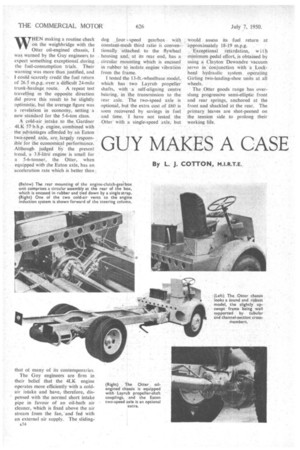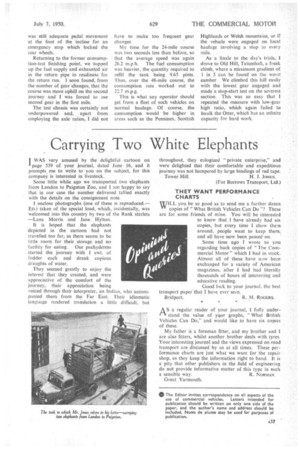GUY MAKES A CASE FOR THE SMALL ENGINE
Page 44

Page 45

Page 46

Page 47

If you've noticed an error in this article please click here to report it so we can fix it.
By L. J. COTTON, M.I.R.T.E.
WHEN making a routine check on the weighbridge with the Otter oil-engined chassis, I was warned by the Guy engineers to expect Something exceptional during the fuel-consumption trials. Their warning was More than justified, and I could scarcely credit the fuel return of 26.5 m.p.g. oyer a difficult 24-mile trunk-haulage. route. A repeat test travelling in the opposite direction did prove this result to be slightly optimistic, but the average figure was a revelation in economy, setting a new standard for the 5-6-ton class.
A cold-air Intake, to the 'Gardner
4LK engine, combined with the advantages afforded by an Eaton twei-speed axle, are.. largely responsible for the economical perforinance. Although judged by the present trend, -a 3.8-litre engine is small for a 5-6-tonner, the Otter, when equipped with the Eaton axle, has an acceleration rate which is better than
that of many of its contemporaries.
The Guy engineers are firm in their belief that the 4LK engine operates more efficiently with a coldair intake and have, therefore, dispensed with the normal short intake pipe in favour of an oil-bath air cleaner, which is fixed above the air stream from the fan, and fed with an external air supply. The sliding
A34 dog four -.speed gearbox. with constant-mesh third ratio is conventionally 'attached to the flywheel housing and, at its rear end, has a circular mounting which is encased in rubber to isolate engine vibration from the frame.
I tested the 13-ft.-wheelbase model, which has two Layrub propeller shafts, with a self-aligning centre bearing, in the transmission to the rear axle. The two-speed axle is optional, but the extra cost of £60 is soon recovered by savings in fuel and time. I have not tested the Otter with a single-speed axle, but
would assess its .fuel return at approximately 1849 m.p.g.
. -Exceptional retardation, with minimum .pedal effort, is obtained by using a Clayton Dewandre vacuum servo in conjunction with a Lockheed hydraulic system operating Girling two-leading-shoe units at all
wheels. • The Otter goods range has overslung progressive semi-elliptic front and rear springs, anchored at the front and shackled at the rear. The primary leaves are shot-peened on the tension side to prolong their working life.
When the test chassis was passed over to me, it was equipped with a cab. in which the small 6ngine occupied little space. A coat of plastic material on the underside of the bonnet effectively . deadened engine noise and formed an efficient. non-conductor of heat, as I found for myself during 80 miles of road work.
The new cab now fitted to the.production models gives a much greater range of vision from the earlier type, for, the windscreen has a minimum
depth of 2 ft. 1 in. More space is provided in the interior. and'the 'cab is constructed on a metal base with wooden vertical pillars covered with light-alloy panels
Standard tyre equipment for the home models is 34 by 7 ins., which was the size fitted to the test chassis. Adequate clearance is provided in the wheel-arch design for 8.25 by 20-in. or 9.00 by 20-in. tyres for overseas models, With a works tester at the wheel, we drove through VVolverhampton to Watling Street for the short-petform ance tests. The brisk acceleration through the town promised a lively , day's work ahead. The addition of a two-speed axle, with an almost instantaneous change through the half-ratios, provided scope for three methods of gear changing to get the optimum performance.
I decided to start by engaging all' four gearbox ratios in succession and keeping the axle in low speed. This practice produced an average time of 17.2 secs. from rest to 20 m.p.h. and 36.4 sees. to 30 m.p.h. Employing the same gearbox technique, but with the high axle ratio engaged, the Otter took 17.1 secs. to reach 20 m.p.h. and 423 secs to attain 30 m.p.h. These results were obtained by normal gear-changing Methods, the sharp deceleration of the engine causing an insignificant delay when engaging a higher ratio.
Rapid Acceleration
Next, the practice was varied to include the half-ratios of the axle. Starting from rest in second-gear low, which is normal driving technique, gears were engaged in thefollowing order: third low, third high, fourth low and fourth high. Acceleration tri 20 m.p.h. occupied 15.4 secs. and to 30 m.p.h. 36.8 secs. Maximum legal speed could be reached in less than 36.8 secs. if theengine were accelerated to governed revolutions in each ratio.
There are not many standard 5-ton oil-engined chassis that could beat the Eaton-axled Otter off the mark. Top-gear acceleration from a chassis of low power-to-weight ratio was again above average, travel. from 10-30 m.p.h. occupying 34 secs. in low ratio and 51.8 secs. in the higher gear of the axle.
The progressive action of the brake system was later put to test. Emergency applications from 20 m.p.h. to 30 m.p.h. caused all wheels to pick-up on a macadamsurfaced road. An average of trials with less effort on the pedal produced stopping distances of 16 ft. and 281 ft. respectively from the two speeds, the former being less than the hypothetical 100 per cent. efficiency, because of slight wheel-lock. With such exceptional stopping power and facings on all shoes, brake servicing should be one of the lesser problems of the maintenance engineei.
A test tank mounted on the frame side-member was connected to the fuel pump arid after driving a short distance to clear air locks from the pipes the tank was filled to a predetermined level and the trials started. The course began on the outskirts of Galley and followed the Watling Street to Oakengates, where we forked back on the Shifnal Road towards Bridgnorth. This included rather more than the usual number of main-road undulations, and the rapid change from the high to the low ratio of the axle helped to reduce running time and keep the engine working at an economical speed.
Good Overall Ratio The maximum road speed on the level and declines never exceeded 30 m.p.h., which, in terms of engine speed with direct-drive gear engaged, is approximately 1,500 r.p.m.
Traffic blocks caused two stops in the 24-mile course, which was covered in precisely 55 minutes, corresponding to an average speed of 26.2 m.p.h In replenishing the fuel supply in the test tank, I poured in 7 pints and, after I had added a further gill, fuel began to flow from
the "level" pipe. This produced an amazing consumption rate of 26.5 imps., which seemed an impos sible result, so I made a second run in the opposite direction.
Before starting the repeat trial, the Otter was driven to Hermitage Hill, Bridgnorth, which involved a I-mile climb with a maximum gradient of 1 in 8. The normal running temperature of the radiator was 134 degrees F. and ambient was 75 degrees F.
Hermitage Hill provided a good test for the Otter, and after the second and third high ratios had been engaged, the steepest section caused a rapid change down to second low gear. The half-ratio to second high was engaged for brief spells and the entire climb occupied 4 mins. 20 secs. There was no increase of radiator-water temperature, the three-quarter-cowled fan and large-capacity radiator providing ample cooling for all normal requirements.
I drove down the bill "on the brakes" with top gear engaged, and there were obvious signs of heating from the facings and drums. There
was still adequate pedal movement at the foot of the 'incline for an emergency stop which locked the rear wheels.
Returning to the former consumption-test finishing point, we topped up the fuel supply and exhausted air in the return pipe in readiness for the return run. I soon found, from the number of gear changes, that the course was more uphill on the second journey and I was forced to use second gear in the first mile.
The test chassis was certainly not underpowered and, apart from employing the axle ratios, I did not
have to make too frequent gear changes.
My time for the 24-mite course was two seconds less than before, so that the average speed was again
26.2 m.p.h. The fuel consumption was heavier, the quantity required to refill the tank being 9.65 pints. Thus, over the 4g-mite course, the consumption rate worked outto 22.7 mpg.
This is what any operator should get from a fleet of such vehicles on normal haulage. Of course, the consumption would be higher in areas such as the Pennines, Scottish Highlands or Welsh mountains, or if the vehicle were engaged on local haulage involving a stop to every mile.
As a finale to the day's trials, I drove to Old Hill, Tattenhall, a freak climb, where a Maximum gradient of 1 in 5 can be found on the worst camber. We climbed this hill easily with the lowest gear engaged and made a stop-start test on the severest section. This was so easy that I repeated the measure with low-gear high ratio, which again failed to baulk the Otter, -which has an infinite capacity for hard work.












































































